3 possible futures for the pandemic (and a scary projection)
Hello, everyone! Welcome to the next edition of Insider Today. Please sign up here.
As a reminder, this is "Insider in your inbox," an email publication that David Plotz and I are writing with the help of many of our excellent journalists. Our goal is to provide you with insight about and analysis of some of the big stories of the day.
Thanks as always for reading. Please feel free to reply to this email and tell us what you like or don't like, and we'll evolve and improve as we go.
—Henry Blodget (henry@insider.com) and David Plotz (david@insider.com)
SUMMARY: Three possible futures for the pandemic, none of which involves it just disappearing. A scary government projection calls for a skyrocketing of new cases by the end of the month. The coronavirus wallops some young people too. Dictators should be tough on the pandemic, but they're botching it. An overlooked detail in a Supreme Court ruling should worry Republicans. The "murder hornet"?! Biden shouldn't release his Senate archives unless Trump releases his tax returns. Mr. Buffett waves the white flag on airlines. The Big 3...
3 possible futures for the pandemic
As the US starts to reopen, researchers have published estimates for the shape of the pandemic. They forecast that the pandemic will last 18 to 24 months, and they describe three scenarios:
1. "Peaks and valleys." In this scenario, the current wave — the second and highest wave on the chart below —will recede over the summer and then be followed by additional waves of similar magnitude for one to two years. The severity will vary by region and country. Different cities and countries may reimplement restrictions and mitigation measures.
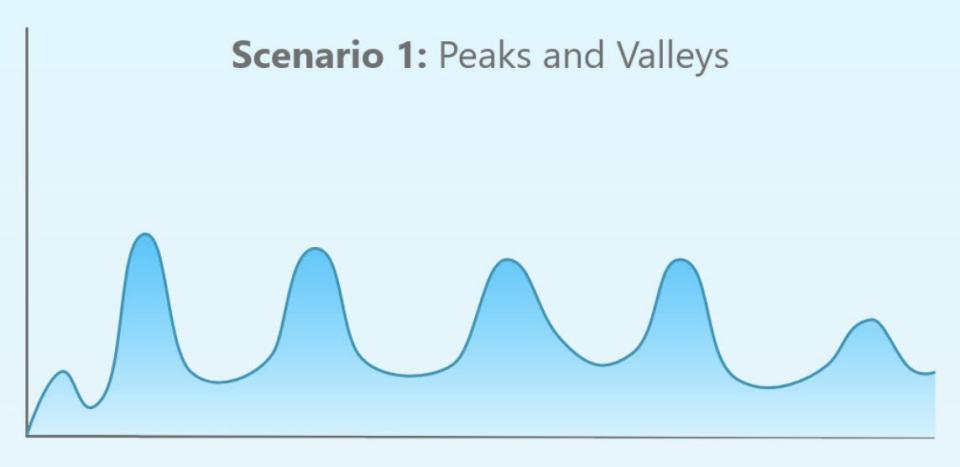
Moore, Lipsitch, Barry, Osterholm
2. "Fall peak." The current wave would recede over the summer, as in the first scenario. But then we would be hit with a far more severe wave this fall. This is what happened in the 1918-19 "Great Influenza" pandemic, as well as less devastating flu pandemics in 1957-58 and 2009-10.
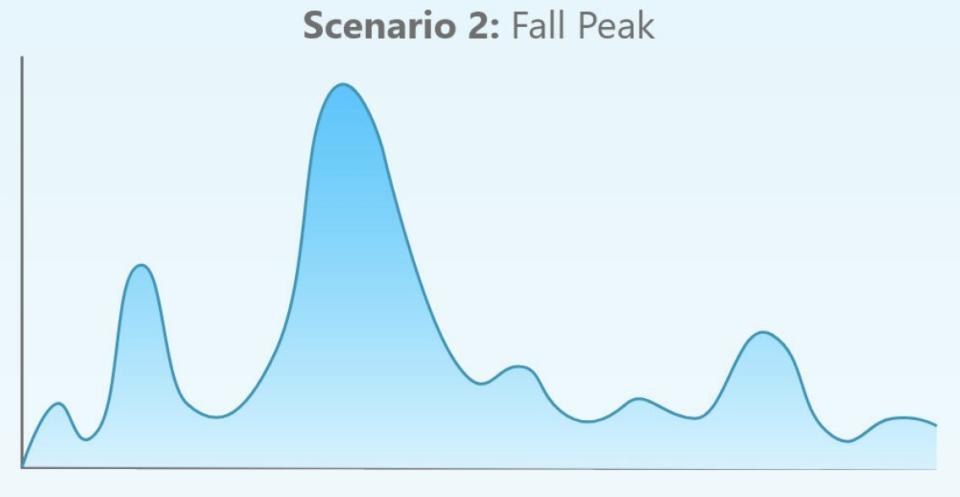
Moore, Lipsitch, Barry, Osterholm
3. "Slow burn." The most encouraging scenario. The current wave is by far the worst. And then the pandemic smolders for an additional few years while life goes on.
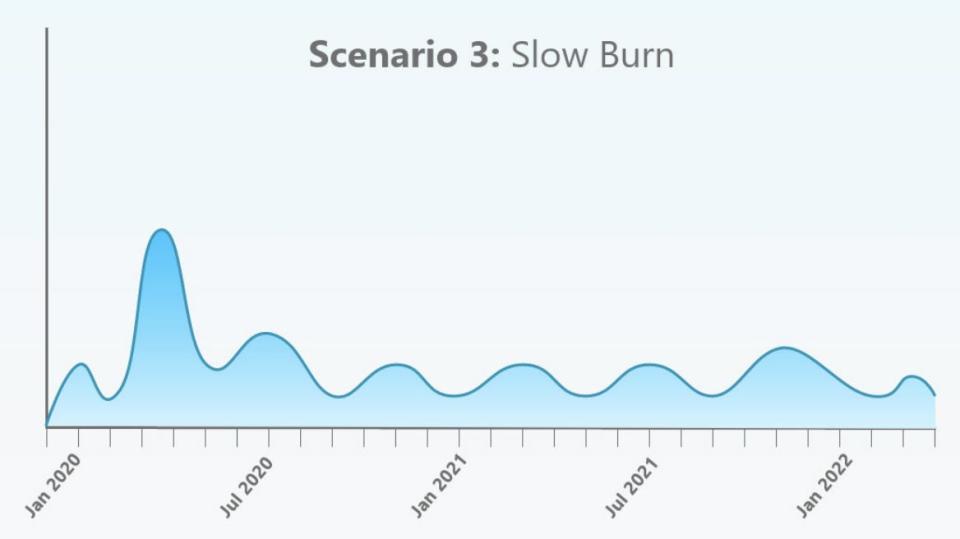
Moore, Lipsitch, Barry, Osterholm
Note that none of these scenarios involves the coronavirus just disappearing after this first big wave recedes.
The researchers do not address the possibility that scientists will develop a powerful drug in the next few months that can "cure" the disease or a vaccine that will prevent it. They note that vaccines have not played a role in prior flu pandemics.
Sharon Begley of STAT News describes each of these scenarios in detail here. —HB
Meanwhile, a government document projects that the US "daily case" and "daily death" rates will skyrocket later this month
The New York Times got its hands on a document described as a "situation update" from the Federal Emergency Management Agency.
The document appears to have been updated through May 1. It includes projections for a radical increase in expected "new cases per day" and "deaths per day" in the second half of this month.

US Department of Homeland Security presentation, via New York Times
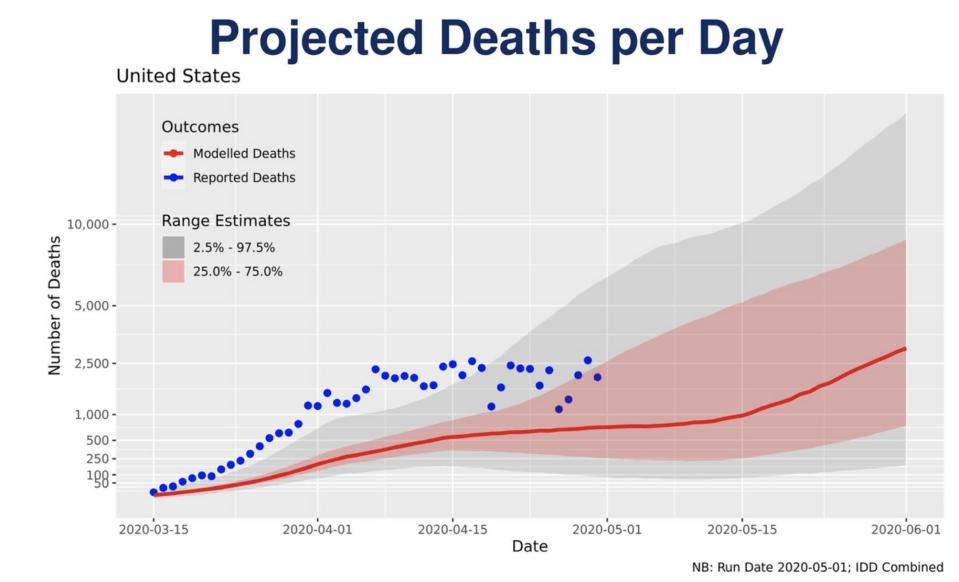
Department of Homeland Security, via New York Times
To emphasize: The top chart calls for the skyrocketing of daily new cases to more than 200,000 by the end of May, up from about 30,000 now.
The presentation does not explain why the model predicts this acceleration.
An hour after the document was published, the White House disavowed it. A White House representative told Insider's Eliza Relman that it "is not a White House document nor has it been presented to the Coronavirus Task Force or gone through interagency vetting" and that "this data is not reflective of any of the modeling done by the task force or data that the task force has analyzed."
So now we need to understand where those projections came from and whether any government experts believe they are realistic.
Here are the historical numbers in the presentation, which have plateaued at about 30,000 new cases and 2,000 deaths per day:
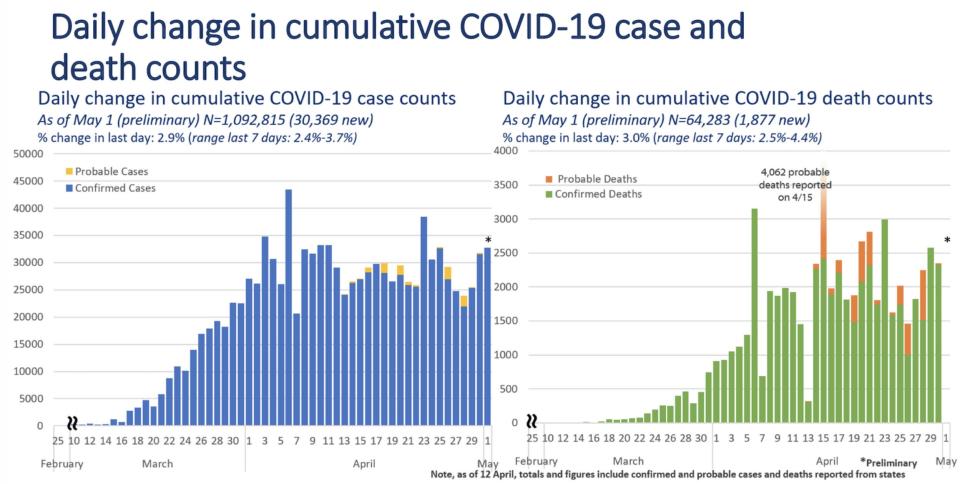
Department of Homeland Security, via New York Times
Yes, the coronavirus is roughest on old and sick people, but it's awful for some younger people too
Insider's Aria Bendix, a healthy reporter in her 20s, developed nasty COVID-19 symptoms in late March, which she described here. Nearly 50 days later, she's still not back to full strength.
Aria's not alone. Here, she interviews four other otherwise healthy people in their 20s and 30s who have been sick for more than a month.
Meanwhile, Insider's Lydia Ramsey describes how doctors in New York City continue to be surprised and alarmed by the number of younger people who are getting COVID-19, as well as how serious it is for some of them.
In New York, 18- to 44-year-olds make up about 10% of total cases. More than 4,300 of them have been hospitalized. Nearly 300 of them have died. —HB
Will summer help?

Getty
There is still hope that warmer temperatures will halt or at least slow the spread of the virus.
The researchers in the study and the article referenced above conclude that summer will reduce the transmissibility of the virus by about 20% — enough to slow it down, but not enough to eliminate it. —HB
Dictators should be great during a pandemic. Why are they botching it?

Sputnik/Alexey Druzhinin/Kremlin/Reuters
Russia's COVID-19 outbreak is blazing, with record cases reported on Sunday. Wouldn't you think Vladimir Putin would be handling it better?
Authoritarians love nothing more than ordering the government to do whatever they want, imposing tight controls on the population, and wantonly enacting emergency restrictions, so you'd expect Putin and his fellow authoritarians to shine during the pandemic. But it's not working out that way.
Across the world, dictators, as well as democratically elected leaders with authoritarian tendencies, are doing poorly. Putin seems bored by the crisis. Iran continues to be a wreck. The dictator of Belarus, denying that the coronavirus is a threat, has ordered life to continue as usual, leading to one of the world's fastest-rising infection rates. Brazilian President Jair Bolsonaro's he-man approach— combining skepticism of science with macho recklessness — has made a mess of Brazil's response.
This isn't a hard-and-fast rule. Plenty of vibrant democracies — Spain, Italy — have struggled with outbreaks, and China almost certainly extinguished its outbreak more rapidly thanks to its totalitarian tools. But in general, controlling the virus seems easier when there's public trust in government, reliable and transparent data, and visible popular support for action — all of which are hard for authoritarians to muster. Also authoritarians tend to prefer problems they can solve quickly with force or rhetoric, neither of which works on the coronavirus.
Oh, and it doesn't help to build trust in public health when any health professional who casts doubt on the government's response falls out a window the next day, as seems to happen in Russia. —DP
Vote-by-mail data that could worry Republicans
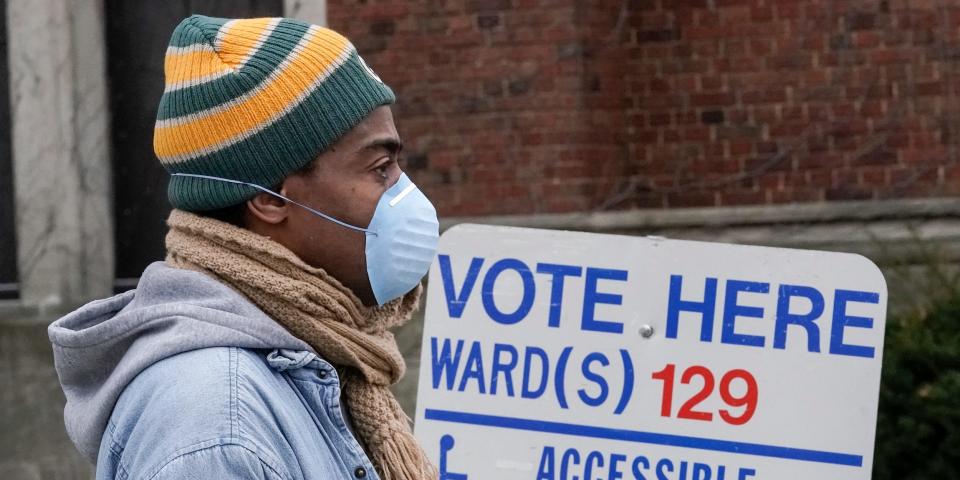
Morry Gash/AP Images
The savage battle over voting by mail in the 2020 election could be shaped by some unexpected news out of Wisconsin. Last month, as Wisconsin held in-person voting during the pandemic, the US Supreme Court refused to extend the deadline for mail-in ballots. The ruling was seen as a big win for Republicans.
Less noticed was that the court did allow Wisconsin to accept ballots postmarked by Election Day. Under previous rules, Wisconsin accepted only ballots that arrived by Election Day. The Washington Post found that in Wisconsin's two biggest cities, 10% of all ballots were postmarked before Election Day and arrived after Election Day. In other words, 10% of voters in those cities wouldn't have even been counted in previous years.
The Wisconsin vote could be anomalous: Wisconsin officials and voters had only a few days to prepare and no precedent for pandemic voting. The rest of the country will have months to set rules for pandemic-afflicted balloting.
Still the Wisconsin mail-in data may alarm Republicans, who generally benefit from fewer people voting. Expect them to seek to limit the SCOTUS ruling and to persuade state legislatures to find other ways to restrict voting by mail. Seven states, all Republican-controlled, have already limited balloting by mail to elderly voters. —DP
What will restaurants and offices look like post-pandemic?

AP Photo/Kin Cheung
Check out this Insider photo essay about restaurants in China after COVID-19: taped-off seats, hand sanitizer on tap, temperature checks at the door. (Meanwhile, in a sign of how hard the virus is to control, the city of Harbin has just closed "dine-in" restaurants after an outbreak.)
And The New York Times speculates how the pandemic will transform open-plan offices into places with sneeze guards, push-down air vents, and way more space between coworkers. It's going to be a good time to be an interior designer. —DP
Just when you were starting to think the worst is over

Shutterstock
Can I introduce you to your new neighbor, the "murder hornet"? —DP
Biden should release his Senate archives only if Trump releases his tax returns
As Insider's Nicole Einbinder reported last week, Joe Biden has 1,875 boxes full of records at the University of Delaware from his time in the Senate that are unavailable to the public. One or two of these boxes, the theory goes, might contain references to Tara Reade, the former staffer who recently accused Biden of sexually assaulting her.
Biden denied the allegations in an interview on Friday and said that the Delaware boxes didn't contain any materials related to Reade.
Reade has said that the boxes aren't likely to contain any references to a sexual assault because she didn't tell Biden's team about it.
Naturally, people are still calling on Biden to unseal all those boxes. If he doesn't, the existence of the boxes threatens to become the same sort of "what's he hiding?" weapon that was used so effectively against Hillary Clinton in 2016. ("But her emails…")
The desire to search all potential evidence to get to the bottom of the story is understandable. But the request that Biden unseal his boxes when President Donald Trump still has yet to release his tax returns seems an absurd double standard. —HB
Warren Buffett gives up on airlines
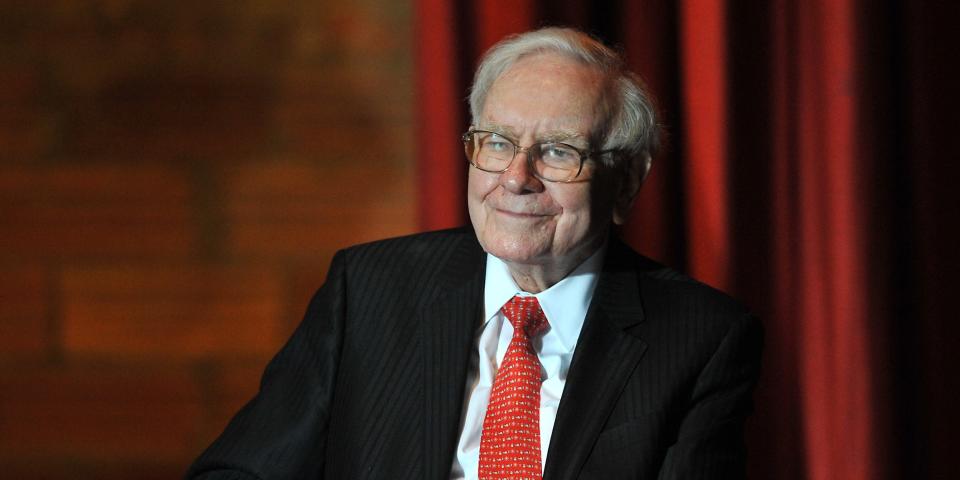
Steve Pope / Getty Images
The Oracle of Omaha announced that he had dumped all his airline holdings. He thinks it's unlikely that as many people will fly in the next two to three years as they did last year. And he believes that even if capacity returns to 70% to 80% of what it once was, the airlines will still have too many planes.
History supports this view.
The last big gut punch to the industry came after 9/11. The fallout from that event was shorter and less devastating than the current one. But still … the economist David Rosenberg of Rosenberg Research points that it took about seven years for travel spending on airlines to recover. —HB
The Big 3*!
YouTubers pretending to be Jimmy Fallon tricked the "Tiger King" star Carole Baskin into doing an interview.
Insider's Lindsay Dodgson has the inside story of who the tricksters are, how they did it, and what they learned about the famous reality-TV star who some think killed her husband and fed him to her big cats.
Former NBA star Charles Barkley has bad news for LeBron James, Kobe Bryant, Wilt Chamberlain, and others who are occasionally thought to be the best of all time: Michael Jordan was better.
Few people who watched Jordan's dominance in the 1990s would disagree.
Trump's latest scapegoat for his bungled coronavirus response is Dr. Anthony Fauci.
The president told Fox News that Fauci told him the virus was no big deal.
*The most popular stories on Insider this morning.
Thank you for reading! Please let us know what you think. If we think other readers will enjoy your note, we'll publish it! henry@insider.com and david@insider.com.
Read the original article on Business Insider

